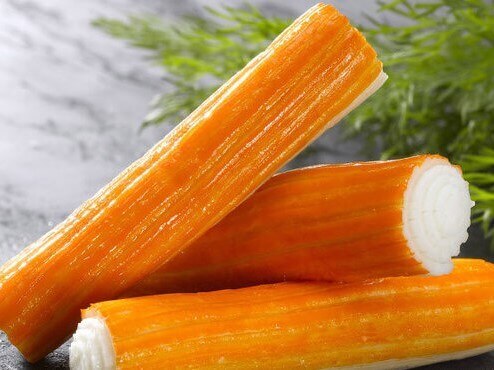One of the common ingredients of sushi rolls is imitation crab. In Japan this is called kanikama (カニカマ), in Europe, it’s called surimi and in the US it’s also called fake crab.
I’m sure everyone reading this has tried it before, but what is imitation crab made of?
 It seems kanikama was invented in Japan. In the early 1970s, Sugiyo, a fish paste manufacturer, in a failed attempt to develop artificial jellyfish, ended up with a product that had a texture exactly like crab and shifted development to that instead.
It seems kanikama was invented in Japan. In the early 1970s, Sugiyo, a fish paste manufacturer, in a failed attempt to develop artificial jellyfish, ended up with a product that had a texture exactly like crab and shifted development to that instead.
What’s the Difference Between Surimi and Kanikama?
Surimi and kanikama are related but not the same. Surimi refers to the base ingredient—a white fish paste made by washing and mincing fish such as Alaska pollock. It is a versatile ingredient used in various processed seafood products like fish balls, kamaboko (steamed fish cake), and imitation crab.
Kanikama, on the other hand, is a finished product made from surimi. The word is short for “kani kamaboko,” meaning “crab-flavored fish cake” in Japanese. It’s processed to look and taste like real crab meat, often with added flavorings, coloring, and shaping to mimic crab leg texture. In short, surimi is the raw material, while kanikama is one of the products made from it.
So while all kanikama is made from surimi, not all surimi becomes kanikama.
The “kani” of “kanikama” means “crab”. “Kama” is an abbreviation of kamaboko, which is boiled fish paste, fish sausage, or fish cake. Its official name is “crab-like kamaboko”. The main ingredient is minced fish meat mashed into a paste. One of the whitefish used is in Alaska pollack. But it contains no crab. Therefore, to bring out the crab flavor, crab extract, which is a combination of ingredients extracted from crab shells and meat, salt, etc., is added. In this way, the crab-like taste can be reproduced without the use of crab meat. However, those who are allergic to crab or other crustaceans cannot eat kanikama containing crab extract. Also, the red color of the crab-like appearance is made with paprika dye, etc.
Is Imitation Crab Vegetarian or Vegan?
Despite being called “fake crab,” imitation crab is not suitable for vegetarians or vegans. Its main ingredient, surimi, is made from minced white fish, making it an animal-based product.
Additionally, some varieties of imitation crab contain additives like crab extract, which is derived from real crab shells or meat. This makes them unsuitable not only for vegetarians and vegans, but also for those with shellfish allergies.
However, in recent years, plant-based alternatives to imitation crab have been developed. These vegan-friendly products are made from ingredients such as soy, konjac (a root vegetable), or starches, and are designed to mimic the taste and texture of traditional kanikama without using any animal-derived ingredients. Always check labels carefully if you follow a vegetarian or vegan diet.
Incidentally, some kanikama sold in the US and Europe actually contain real crab.
It has now become a staple not only in sushi rolls, but also in sandwiches or on baguettes and even on takeout salads. It’s become even more popular than it is within Japan.
Related contents:
We hope this information will be helpful.

Revision date: July 7, 2025
Share this article